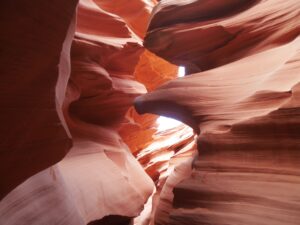There is a saying in Ancient Greek, attributed to the philosopher Heraclitus. That phrase, in Greek, is “τὰ πάντα ῥεῖ καὶ οὐδὲν μένει” (ta panta rhei kai ouden menei). It roughly translates to, “everything flows, and nothing stays.” Another saying attributed to Heraclitus along this vein is that you can’t step into the same river twice. Both of these sayings can be summarized in two words: everything changes. The water that flows in a river is always shifting and flowing, so that when you step into a river for a second time, it is no longer the same river. The same could be said about our life that flows like a river. Plato wrote that when we’re able to negate both being and non-being, we discover absolute nothingness, and that within that absolute nothingness we discover the absolute present – which is itself the Ultimate Reality. No such understanding can come without a mystic’s eye.
That brings me to the dharma teachings of the Buddha and concepts such as Shunyata, Emptiness, Void, Oneness, Suchness, Buddha Mind, Nirvana, Tathata, Absolute Reality, Dharmakaya: these are all word-symbols that, paradoxically, seek to express the ineffable. We cannot explain them, for they rely on direct experience to understand, but, like the monk pointing his finger at the moon, we can point in the direction of their meaning.
There are those nihilists and others who consider the Emptiness that Zen Buddhist’s speak of as a negative, dark thing, leading them to classify Buddhism as an atheistic religion, one that believes in nothing. What such people lack in wisdom and understanding they make up for in ignorance, for the Emptiness we speak of in Zen could just as easily be called Fullness – for it is within Emptiness that all exists! Outside of Emptiness there is only illusion, and within illusion, Samsara – a world of stress and suffering.
Emptiness is not destruction, but salvation. Emptiness is neither absolute nothing nor non-existence of everything. Emptiness is Original Purity, the Essence within all things. Emptiness does not mean non-existence. We cannot say that our Buddha Mind, our essence, does not exist just because, like space, it is empty and has no absolute form. Like Space, our Buddha Mind embraces all things, it simply does not exist separate, or apart, from all else. When one wants to see the truth one cannot be for or against it. “To look at emptiness as a purely intellectual concept,” Ed. Conze writes, “or to make it into a thing and give it an ontological meaning would be a mistake.” When we mistake the word ‘Emptiness’ for the symbol it represents, we give it a false, destructive, exegesis because intellectually it cannot be realized.
We need to take a glance of emptiness. Following the Teachings of the Buddha, if we begin with Right Understanding, we can examine our body to see it for what it really is – not something lasting, but something in a constant state of change and degeneration. To see things clearly for what they are gives us immense freedom, for it allows us to let go of the darkness: the fears and insecurities that come with false understanding. Imagine diving into a powerful microscope, following the trajectory of the viewer toward that infinitesimal spot within a single pore of our skin. As we approach we see the cells, and closer still we see the individual molecules they are made of, then the atoms those are made of, then the electrons, then the protons and neutrons, then the quarks, and other strange particles, then the loops of energy called strings that physicist speculate about – loops of pure energy interacting with one another across space and time to create the “stuff” we take for reality in our material world. Our eyes see the effects, not the cause. Only our inner-eyes – our Buddha Nature — can see the cause, a cause that exists within the realm of Emptiness.
Looking into that emptiness for the first time activates our Buddha Mind and brings with it the revelation of an infinite universe. With continued presence in Buddha Mind we understand the nature of birth and death, the law of cause and effect, and the nature of the “ten thousand things” arising, swirling and disappearing – they are following the Law of Dharma. We see that everything changes all the time, endlessly; that all is in constant motion. This notion is not the sole property of Buddhism; Heraclitus, the great Greek philosopher responsible for shaping much of Western thought over 2500 years ago, embodied the concept of constant change, that all is in perpetual flux, with the famous phrase, Ta panta rei. But to come upon this ourselves requires stillness. Only when we are still, when our minds are still, can we see the ephemeral, yet eternal, movement of Emptiness swarming within and around us.
Emptiness here, emptiness there, But the infinite universe stands always before your eyes.
– Xsin Xin Ming
But we can not still the mind when we are pointing our gaze, our attention, on the macrocosm – on the “things” of the material world. When we do that, our attention falters and frightening thoughts may arise: ”Where am I in all this? Where is my sense of self – my ego? Where is my identity? I don’t want to lose that!” When this happens, we must reflect on the thoughts, and fears, themselves asking ourselves why we care so much about clinging onto an illusion. We cannot get past this phase until we literally give up. We just have to give ourselves up if we are to transcend ourselves.
In the emptiness of a genuine silence of mind we come to realize that we are dwelling nowhere after all, but in emptiness, and that that emptiness contains everything. We come to see truly that Form is Emptiness and Emptiness is Form, as we have only previously read about in the Heart Sutra, the Sublime Teaching of the Prajna Paramita.
Why is the realization of emptiness sublime? Can there be nothing more profound than discovering a reality (the Reality) outside our normal, imagined, reality of this material world? In the genuine silence of the mind that takes us on this fantastic journey, we come to realize Emptiness directly. It is outside the mental constructs of words and symbols because it is not of the nature of words and symbols.
True emptiness is not empty. Meditation is not enough, unwavering practice of awareness is needed too. We use practices such as the Hua Tou to cultivate this awareness and help us detach from our mental clingings and false understandings of the nature of reality. With diligent practice, the essence manifests itself to us naturally and we recognize the interpenetrating nature of the Whole.
Buddha Mind is Emptiness
In awe, we recognize that there is nothing to grab onto anywhere, because emptiness penetrates all. Seeing clearly, we recognize that things are what they seemed when we were under the hold of the ego. “In the leap,” in awareness, getting rid of the ego in spiritual emptiness, waiting for God. Looking back on our life without this knowledge we see only a world of pain and suffering.
Making our home in the flow, we understand that all that flows has no beginning and no end. In this impermanence we escape from life and death. We understand that life and death are just two points on an infinite spectrum of change, that our True Nature IS that change.
We recognize that all things are essentially empty, that there is no place of being belonging to “me” or to “you” or to “us.” There is no self that is separate from all that is. There is no more perfect knowledge than this.
A door opens in the darkness and a warm light enters, beckoning us to enter the Way of spiritual sight. Do we walk through the door, or do we turn around and run the other direction in fear of the unknown? When we choose the door, refusing to grasp onto our old ways of conceiving ourselves, we come to understand plainly, with crystal clarity, the Scriptures, the Buddha, the Maters, and the Patriarchs. In short, we come to understand what all the fuss has been about for so many thousands of years! “If you grasp at Emptiness, you will fall into evil and heterodox views. Nor will you grasp at Existence or at the Wonderful. If you grasp at Existence, you will also fall into evil ways.”
— Patriarch Han Shan
Dwell in the middle way, neither denying nor asserting. Be “in the leap” – a watcher, aware. Maintain this state with all your might and you will find complete liberation. It depends on firm commitment to Right Concentration, meditation, and practice. You will soon enter a new state of awareness, seeing emptiness in all things, a state of no-self, and no-mind. And just like a student graduating from one class gains entrance to the next, so continues our evolving understanding of Reality. Even in making a first step toward that door that leads out of the darkness, a subtle joy will arise in your heart.
All is One, One is in all
And so it is, if you are reading this, we want to tell you that everything will be fine. You are incredible, you are unique, you can face anything in your life, you have the strength within yourself to overcome any obstacle, loss, or situation. You are not alone, you are loved, you have the right to feel bad and good, you have the right to feel. Be blessed by these positive vibes of harmony and compassion. And live your life to the fullest. We are sending our Metta or Loving Kindness love to the universe so that we can reach all of you.

